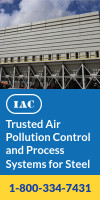Fitch: Weak Steel Market Means Iron Ore Rally Likely to End Soon
02/05/2013 - The sharp rebound in iron ore prices over the last couple of months will hurt margins at non-integrated steel producers in the first quarter of 2013, but is unlikely to be sustainable due to the weak demand for steel, Fitch Ratings says.
The sharp rebound in iron ore prices over the last couple of months will hurt margins at non-integrated steel producers in the first quarter of 2013, but is unlikely to be sustainable due to the weak demand for steel, Fitch Ratings says. This should help margins recover later in the year.
While the agency expects margin pressures to abate, it says iron ore prices have become more volatile as supply contracts have moved from annual to quarterly or spot pricing, with volatility rising 16% in 2012. This means that both higher-cost producers and consumers of iron ore face higher uncertainty on cash flows.
Iron ore prices have risen around 30% since the start of December, while the price of semi-finished steel products has remained practically unchanged, putting pressure on profits at steelmakers that don't have their own ore supplies. The recovery of iron ore prices follows a fall to their lowest level in more than three years in September. This primarily resulted from destocking by Chinese steel mills. It is likely that the fall in prices resulted in some Chinese mines temporarily halting production, providing further impetus for a price rebound.
But the balance of power in price negotiations is likely to swing back towards steel producers for the rest of the year due to the slowing growth in demand for steel products. Steel producers are unable to transfer increased iron ore costs to customers through an increase of steel products' prices and also have limited ability to absorb increased costs by themselves due to already low operating margins. In Europe weak demand from the construction and automotive markets will lead to a drop in steel production, while in China we believe the rate of steel demand growth has peaked - although production volumes will continue to increase, the rate of growth is likely to be below 5% a year.
These trends mean we expect the ratio of iron ore to steel slab prices to remain close to the 2012 level of 0.25x, rather than the high of 0.29x reached in 2010, Fitch said.



.jpg?lang=en-US&ext=.jpg)
.gif?width=220&height=200&mediaprotectionhash=374c6b9a31f2b2fbfc7937391034efb46fd57feba997b9ad2ae9a0bd3d48329d&ext=.gif)

.gif?width=100&height=200&mediaprotectionhash=e2d5b15d68f84f22038524be6c58e5268d67b7f44494b544e29a8d53c5b959ba&ext=.gif)


